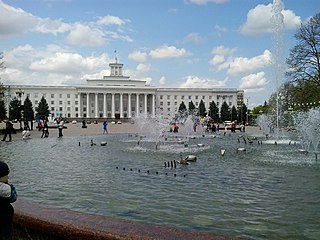
Nalchik is the capital city of Kabardino-Balkaria, Russia, situated at an altitude of 550 meters (1,800 ft) in the foothills of the Caucasus Mountains; about 100 kilometers (62 mi) northwest of Beslan. It covers an area of 131 square kilometers (51 sq mi). Population: 247,054 (2021 Census); 240,203 (2010 Census); 274,974 (2002 Census); 234,547 (1989 Census).
An Autonomous Soviet Socialist Republic was a type of administrative unit in the Soviet Union (USSR) created for certain nations. The ASSRs had a status lower than the constituent union republics of the USSR, but higher than the autonomous oblasts and the autonomous okrugs.

Kabardino-Balkaria, officially the Kabardino-Balkarian Republic, is a republic of Russia located in the North Caucasus. As of the 2021 Census, its population was 904,200. Its capital is Nalchik. The area contains the highest mountain in Europe, Mount Elbrus, at 5,642 m (18,510 ft). Mount Elbrus has 22 glaciers that feed three rivers — Baksan, Malka and Kuban. The mountain is covered with snow year-round.

Valery Mukhamedovich Kokov was a Soviet and Russian politician of Kabardian ethnicity.
The Republic of Kabardino-Balkaria is a federal subject of Russia, located in the Caucasus region.
Muslim Atayev, also known as Emir Sayfullah, was the founder of the militant organization Yarmuk Jamaat, which later became part of the Caucasus Front's Kabardino-Balkarian Sector in the Russian-held Caucasian Muslim state Kabardino-Balkaria of the Second Chechen War. Atayev was an ethnic Balkar and started his military career as a volunteer fighting in Chechnya.
Russia, the largest country in the world, has international land borders with 14 sovereign states as well as 2 narrow maritime boundaries with the United States and Japan. There are also two breakaway states bordering Russia, namely Abkhazia and South Ossetia. The country has an internationally recognized land border running 22,407 kilometres (13,923 mi) in total, and has the second-longest land border of any country in the world, after China. The borders of the Russian Federation were mostly drawn since 1956, and have remained the same after the dissolution of the Soviet Union. In 2014, Russia annexed Ukraine's Crimean peninsula in a move that remains internationally unrecognized.
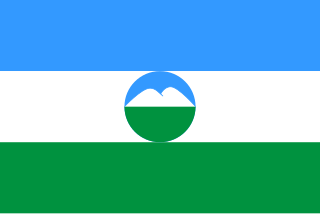
The flag of Kabardino-Balkaria in the Russian Federation is a horizontal tricolour, charged with a white silhouette of Mount Elbrus, the highest mountain in Europe, in the center. The colors are arranged in the order of light blue, white, and green, with the charge of Mount Elbrus following the same order.
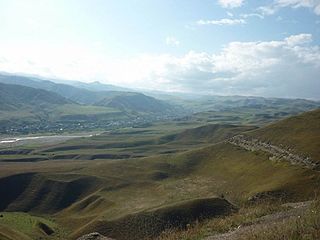
Baksansky District is an administrative and a municipal district (raion), one of the ten in the Kabardino-Balkarian Republic, Russia. It is located in the north of the republic. The area of the district is 829.58 square kilometers (320.30 sq mi). Its administrative center is the town of Baksan. As of the 2010 Census, the total population of the district was 60,970.

The Kabardino-Balkarian Autonomous Soviet Socialist Republic was an autonomous republic of the Russian Soviet Federative Socialist Republic within the Soviet Union, and was originally a part of the Mountain Autonomous Soviet Socialist Republic. On 16 January 1922 the region was detached from the Mountain ASSR and the Kabardino-Balkarian Autonomous Oblast on 1 September 1921. It became an autonomous republic on 5 December 1936. On 30 January 1991, the Kabardino-Balkarian ASSR declared state sovereignty. It is now the Kabardino-Balkaria republic, a federal subject of the Russian Federation. The Kabardino-Balkarian ASSR bordered no other sovereign states during the existence of the Soviet Union.
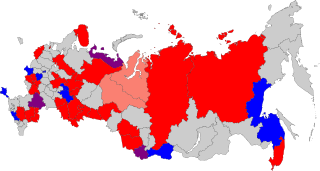
Election Day in Russia was held on September 14, 2014.
The First Secretary of the Kabardino–Balkarian regional branch of the Communist Party of the Soviet Union was the position of highest authority in the Kabardino-Balkarian AO (1921–1936), Kabardino-Balkarian ASSR and the Kabardin ASSR (1944–1957) in the Russian SFSR of the Soviet Union. The position was created in 1921, and abolished in August 1991. The First Secretary was a de facto appointed position usually by the Politburo or the General Secretary himself.

Yury Alexandrovich Kokov is a Russian politician who was served as Head of Kabardino-Balkaria from 2013 to 2018.
Zaur Nazhidovich Tutov (Russian: Заур Нажидович Тутов; born October 2, 1951, Staraya Krepost village is a singer. People's Artist of the Russian Federation. Minister of Culture and Information Communications of Kabardino-Balkaria.
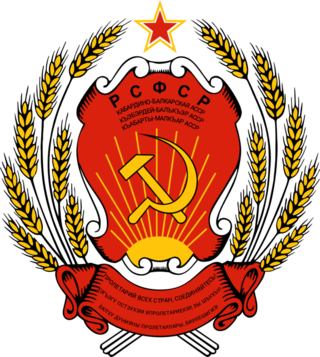
The national emblem of the Kabardino-Balkarian Autonomous Soviet Socialist Republic was adopted in 1937 by the government of the Kabardino-Balkarian Autonomous Soviet Socialist Republic. The emblem is identical to the emblem of the Russian Soviet Federative Socialist Republic.

The flag of the Kabardino-Balkarian Autonomous Soviet Socialist Republic was adopted in 1957 by the government of the Kabardino-Balkarian Autonomous Soviet Socialist Republic. The flag is identical to the flag of the Russian Soviet Federative Socialist Republic.

Kabardino-Balkarian State University (KBSU); Russian: Кабардино-Балкарский государственный университет имени Х. М. Бербекова Kabardino_Balkarskii gosudarstvennii universitet imeni H. M. Berbekova, often abbreviated КБГУ, KBSU) is a coeducational and public research university located in Nalchik, Kabardino-Balkaria, Russia. It was founded on April 5, 1957. The university is recognized by the Ministry of Science and Higher Education of the Russian Federation. It is one of the largest universities in the North Caucasus. Its current rector is Altudov Y.K. Kabardino-Balkarian State University has all the modern facilities in terms of infrastructure and education. The classroom is equipped with smart education systems and students are provided with the facility to learn virtually if they miss classes in campus. The university library is well-modernized and more than 30% of the seats are equipped with high-tech computer systems.

Zaur Gekkiyev is a Russian political figure and a deputy of the 6th, 7th and 8th State Dumas.

Adalby Shkhagoshev is a Russian political figure and deputy of the 5th, 6th, 7th, and 8th State Dumas.
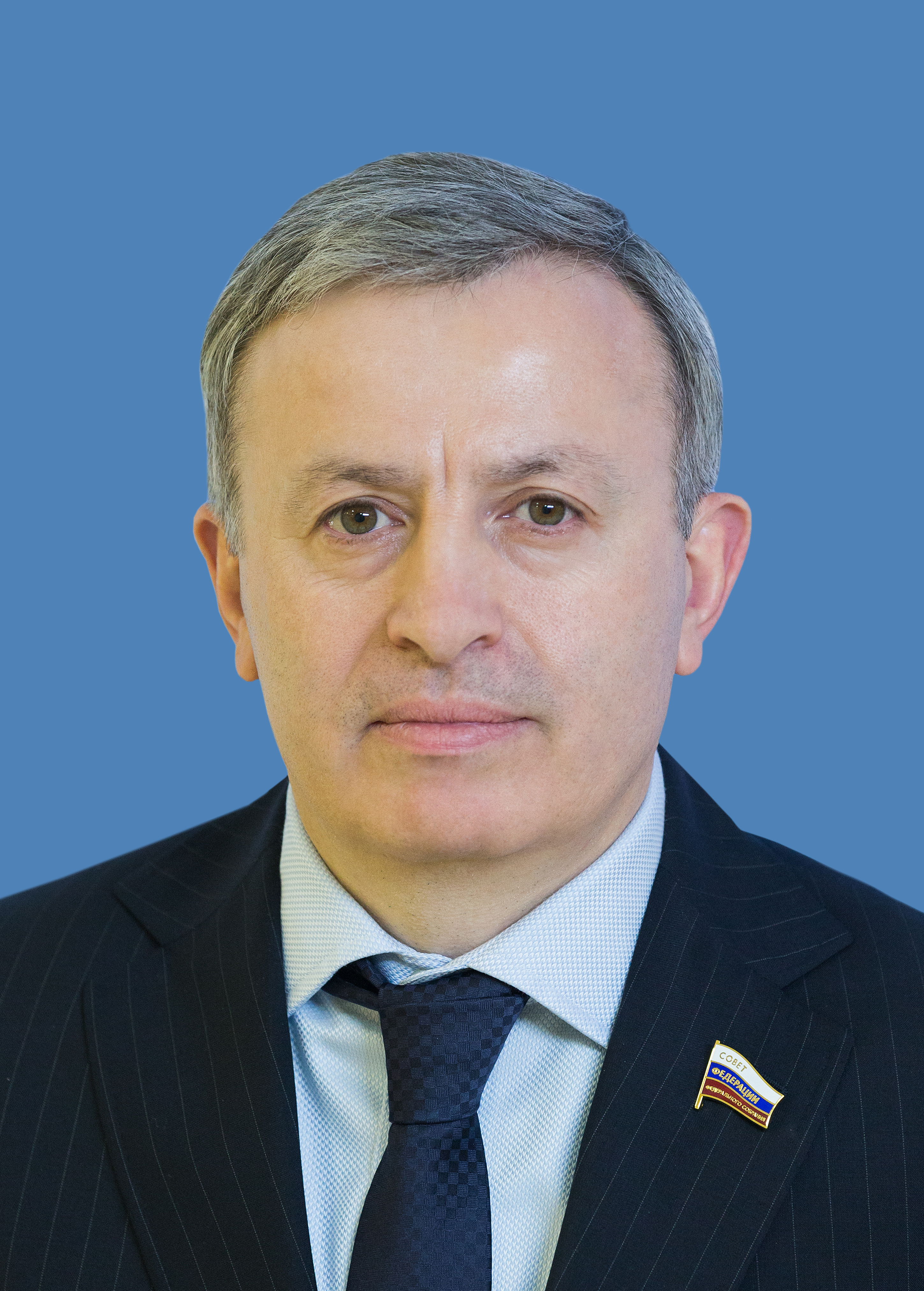
Mukharby Ulbashev is a Russian politician serving as a senator from Kabardino-Balkaria since 23 September 2019.












